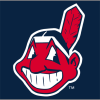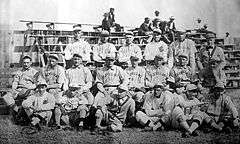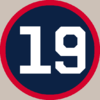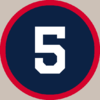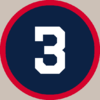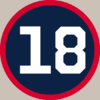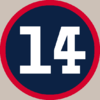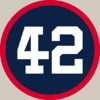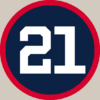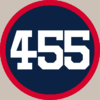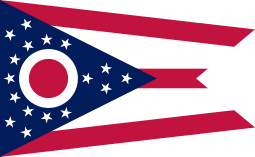Cleveland Indians
| Cleveland Indians | |||||
|---|---|---|---|---|---|
|
| |||||
| Established in 1894 | |||||
| |||||
| Major league affiliations | |||||
| |||||
| Current uniform | |||||
 | |||||
| Retired numbers | |||||
| Colors | |||||
| Name | |||||
| Other nicknames | |||||
| |||||
| Ballpark | |||||
| |||||
| Major league titles | |||||
| World Series titles (2) | |||||
| AL Pennants (6) | |||||
| Central Division titles (8) | |||||
| Wild card berths (1) | 2013 | ||||
| Front office | |||||
| Owner(s) |
| ||||
| Manager | Terry Francona | ||||
| General Manager | Mike Chernoff | ||||
| President of Baseball Operations | Chris Antonetti | ||||
The Cleveland Indians are an American professional baseball team based in Cleveland, Ohio. The Indians compete in Major League Baseball (MLB) as a member club of the American League (AL) Central division. Since 1994, they have played at Progressive Field. The team's spring training facility is at Goodyear Ballpark in Goodyear, Arizona.[2] Since their establishment as a major league franchise in 1901, the Indians have won two World Series championships: in 1920 and 1948, along with eight Central Division titles and six American League pennants. The Indians' current World Series championship drought is the longest active drought, and through 2016 is the fifth-longest in baseball history.[3]
The name "Indians" originated from a request by club owner Charles Somers to baseball writers to choose a new name to replace "Cleveland Naps" following the departure of Nap Lajoie after the 1914 season. The name referenced the nickname "Indians" that was applied to the Cleveland Spiders baseball club during the time when Louis Sockalexis, a Native American, played in Cleveland.[4] Common nicknames for the Indians include the "Tribe" and the "Wahoos", the latter being a reference to their logo, Chief Wahoo, a controversial Native American caricature. The team's mascot is named "Slider."
The franchise originated in Grand Rapids, Michigan, in 1894 as the Grand Rapids Rustlers, a minor league team in the Western League. The team moved to Cleveland in 1900 and changed its name to the Cleveland Lake Shores; the Western League itself changed its name to the American League while continuing its minor league status. One of the American League's eight charter franchises, the major league incarnation of the club was founded in Cleveland in 1901. Originally called the Cleveland Bluebirds, the team played in League Park until moving permanently to Cleveland Stadium in 1946. At the end of the 2016 season, they had a regular season franchise record of 9,191–8,837 (.510).
Cleveland baseball prior to the Indians franchise
"In 1857 baseball games were a daily spectacle in Cleveland's Public Squares. City authorities tried to find an ordinance forbidding it, to the joy of the crowd, they were unsuccessful. – Harold Seymour" [5]
- 1865–1868 Forest Citys of Cleveland (Minor League)
- 1869–1872 Forest Citys of Cleveland

From 1865 to 1868 Forest Citys was an amateur ball club. During the 1869 season, Cleveland was among several cities which established professional baseball teams following the success of the 1869 Cincinnati Red Stockings, the first fully professional team. In the newspapers before and after 1870, the team was often called the Forest Citys, in the same generic way that the team from Chicago was sometimes called The Chicagos.
In 1871 the Forest Citys joined the new National Association of Professional Base Ball Players (NA), the first professional league. Ultimately, two of the league's western clubs went out of business during the first season and the Chicago Fire left that city's White Stockings impoverished, unable to field a team again until 1874. Cleveland was thus the NA's westernmost outpost in 1872, the year the club folded. Cleveland played their full schedule to July 19 followed by two games versus Boston in mid-August and disbanded at the end of the season.[6]
- 1879–1881 Cleveland Forest Citys
- 1882–1884 Cleveland Blues
In 1876, the National League (NL) supplanted the NA as the major professional league. Cleveland were not among its charter members, but by 1879 the league was looking for new entries and the city gained an NL team. The Cleveland Forest Citys baseball team was then re-created. The National League required distinct colors for the 1882 season, so the Cleveland Forest Citys became the Cleveland Blues. They then had a mediocre record for six seasons and were ruined by a trade war with the Union Association (UA) in 1884, when its three best players (Fred Dunlap, Jack Glasscock, and Jim McCormick) jumped to the UA after being offered higher salaries. Cleveland Blues merged with the St. Louis Maroons UA team in 1885.
- 1887–1899 Cleveland Spiders — nickname "Blues"
Cleveland went without major league baseball for two seasons until gaining a team in the American Association (AA) in 1887. After the AA's Allegheny club jumped to the NL Cleveland followed suit in 1889, as the AA began to crumble. The Cleveland ball club, named the Spiders (supposedly inspired by their "skinny and spindly" players) slowly became a power in the league.[7] The next year the Spiders moved into League Park, which would serve as the home of Cleveland professional baseball for the next 55 years. Led by native Ohioan Cy Young, the Spiders became a contender in the mid-1890s, when they played in the Temple Cup Series (that era's World Series) twice, winning it in 1895. The team began to fade after this success, and was dealt a severe blow under the ownership of the Robison brothers
Prior to the 1899 season, Frank Robison, the Spiders owner, bought the St. Louis Browns, thus owning two clubs at the same time. The Browns were renamed the "Perfectos", and restocked with Cleveland talent. Just weeks before the season opener, most of the better Spiders players were transferred to St. Louis, including three future Hall of Famers: Cy Young, Jesse Burkett and Bobby Wallace. [8] The roster maneuvers failed to create a powerhouse Perfectos team, as St. Louis finished fifth in both 1899 and 1900. The Spiders were left with essentially a minor league lineup, and began to lose games at a record pace. Drawing almost no fans at home, they ended up playing most of their season on the road, and became known as "The Wanderers."[9] The team ended the season in 12th place, 84 games out of first place, with an all-time worst record of 20-134 (.130 winning percentage).[10] Following the 1899 season, the National League disbanded four teams, including the Cleveland franchise. The disastrous 1899 season would actually be a step toward a new future for Cleveland fans the next year.
- 1890, Cleveland Infants — nickname "Babes"
The Cleveland Infants were in the Players' League. The League was well-attended, at least in some cities, but was underfunded and its owners lacked the confidence to continue beyond the one season. There were eight teams who were star-studded; the Boston franchise won the championship. The Cleveland Infants finished with 55 wins and 75 losses. Their home games were played at Brotherhood Park.[11]
Franchise history
1894–1935: Beginning to middle
The Grand Rapids Rustlers were founded in Michigan in 1894 and were part of the Western League. In 1900 the team moved to Cleveland and was named the Cleveland Lake Shores. Around the same time Ban Johnson changed the name of his minor league (Western League) to the American League. In 1900 the American League was still considered a minor league. In 1901 team was renamed the Cleveland Bluebirds when the American League broke with the National Agreement and declared itself a competing Major League. The Cleveland franchise was among its eight charter members.
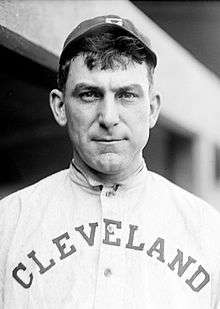
The new team was owned by coal magnate Charles Somers and tailor Jack Kilfoyl. Somers, a wealthy industrialist and also co-owner of the Boston Americans, lent money to other team owners, including Connie Mack's Philadelphia Athletics, to keep them and the new league afloat. Players didn't think the name "Bluebirds" was suitable for a baseball team.[12] Writers frequently shortened it to Cleveland Blues due to the players' all-blue uniforms,[13] but the players didn't like this unofficial name either. The players themselves tried to change the name to Cleveland Broncos in 1902, but this unofficial name never really caught on.[12]
The Bluebirds suffered from financial problems in their first two seasons. This led Somers to seriously consider moving to either Pittsburgh or Cincinnati. Relief came in 1902 as a result of the conflict between the National and American Leagues. In 1901, Napoleon "Nap" Lajoie, the Philadelphia Phillies' star second baseman, jumped to the A's after his contract was capped at $2,400 per year—one of the highest-profile players to jump to the upstart AL. The Phillies subsequently filed an injunction to force Lajoie's return, which was granted by the Pennsylvania Supreme Court. The injunction appeared to doom any hopes of an early settlement between the warring leagues. However, a lawyer discovered that the injunction was only enforceable in the state of Pennsylvania.[12] Mack, partly to thank Somers for his past financial support, agreed to trade Lajoie to the then-moribund Blues, who offered $25,000 salary over three years.[14] Due to the injunction, however, Lajoie had to sit out any games played against the A's in Philadelphia.[15] Lajoie arrived in Cleveland on June 4 and was an immediate hit, drawing 10,000 fans to League Park. Soon afterward, he was named team captain, and in 1903 the team was renamed the Cleveland Napoleons (soon shortened to Naps) after a newspaper conducted a write-in contest.[12]
Lajoie was named manager in 1905, and the team's fortunes improved somewhat. They finished half a game short of the pennant in 1908.[16] However, the success did not last and Lajoie resigned during the 1909 season as manager but remained on as a player.[17]
After that, the team began to unravel, leading Kilfoyl to sell his share of the team to Somers. Cy Young, who returned to Cleveland in 1909, was ineffective for most of his three remaining years[18] and Addie Joss died from tubercular meningitis prior to the 1911 season.[19]
Despite a strong lineup anchored by the potent Lajoie and Shoeless Joe Jackson, poor pitching kept the team below third place for most of the next decade. One reporter referred to the team as the Napkins, "because they fold up so easily". The team hit bottom in 1914 and 1915, finishing in the cellar both years.[20][21]
1915 brought significant changes to the team. Lajoie, nearly 40 years old was no longer a top hitter in the league, batting only .258 in 1914. With Lajoie engaged in a feud with manager Joe Birmingham, the team sold Lajoie back to the A's.[22]
With Lajoie gone, the club needed a new name. Somers asked the local baseball writers to come up with a new name, and based on their input, the team was renamed the Cleveland Indians.[23] The name referenced the nickname "Indians" that was applied to the Cleveland Spiders baseball club during the time when Louis Sockalexis, a Native American, played in Cleveland (1897–99).[24]
At the same time, Somers' business ventures began to fail, leaving him deeply in debt. With the Indians playing poorly, attendance and revenue suffered.[25] Somers decided to trade Jackson midway through the 1915 season for two players and $31,500, one of the largest sums paid for a player at the time.[26]
By 1916, Somers was at the end of his tether, and sold the team to a syndicate headed by Chicago railroad contractor James C. "Jack" Dunn.[25] Manager Lee Fohl, who had taken over in early 1915, acquired two minor league pitchers, Stan Coveleski and Jim Bagby and traded for center fielder Tris Speaker, who was engaged in a salary dispute with the Red Sox.[27] All three would ultimately become key players in bringing a championship to Cleveland.

Speaker took over the reins as player-manager in 1919, and would lead the team to a championship in 1920. On August 16, the Indians were playing the Yankees at the Polo Grounds in New York. Shortstop Ray Chapman, who often crowded the plate, was batting against Carl Mays, who had an unusual underhand delivery. It was also late in the afternoon and the infield would have been in shadow with the center field area (the batters' background) bathed in sunlight. As well, at the time, "part of every pitcher's job was to dirty up a new ball the moment it was thrown onto the field. By turns, they smeared it with dirt, licorice, tobacco juice; it was deliberately scuffed, sandpapered, scarred, cut, even spiked. The result was a misshapen, earth-colored ball that traveled through the air erratically, tended to soften in the later innings, and as it came over the plate, was very hard to see."[28]
In any case, Chapman did not move reflexively when Mays' pitch came his way. The pitch hit Chapman in the head, fracturing his skull. Chapman died the next day, becoming the only player to sustain a fatal injury from a pitched ball.[29] The Indians, who at the time were locked in a tight three-way pennant race with the Yankees and White Sox,[30] were not slowed down by the death of their teammate. Rookie Joe Sewell hit .329 after replacing Chapman in the lineup.[31]
In September 1920, the Black Sox Scandal came to a boil. With just a few games left in the season, and Cleveland and Chicago neck-and-neck for first place at 94–54 and 95–56 respectively,[32][33] the Chicago owner suspended eight players. The White Sox lost two of three in their final series, while Cleveland won four and lost two in their final two series. Cleveland finished two games ahead of Chicago and three games ahead of the Yankees to win its first pennant, led by Speaker's .388 hitting, Jim Bagby's 30 victories and solid performances from Steve O'Neill and Stan Coveleski. Cleveland went on to defeat the Brooklyn Robins 5–2 in the World Series for their first title, winning four games in a row after the Robins took a 2–1 Series lead. The Series included three memorable "firsts", all of them in Game 5 at Cleveland, and all by the home team. In the first inning, right fielder Elmer Smith hit the first Series grand slam. In the fourth inning, Jim Bagby hit the first Series home run by a pitcher. And in the top of the fifth inning, second baseman Bill Wambsganss executed the first (and only, so far) unassisted triple play in World Series history, in fact the only Series triple play of any kind.
The team would not reach the heights of 1920 again for 28 years. Speaker and Coveleski were aging and the Yankees were rising with a new weapon: Babe Ruth and the home run. They managed two second-place finishes but spent much of the decade in the cellar. In 1927 Dunn's widow, Mrs. George Pross (Dunn had died in 1922), sold the team to a syndicate headed by Alva Bradley.
1936–46: Bob Feller enters the show
The Indians were a middling team by the 1930s, finishing third or fourth most years. 1936 brought Cleveland a new superstar in 17-year-old pitcher Bob Feller, who came from Iowa with a dominating fastball. That season, Feller set a record with 17 strikeouts in a single game and went on to lead the league in strikeouts from 1938–1941.

On August 20, 1938, Indians catchers Hank Helf and Frank Pytlak set the "all-time altitude mark" by catching baseballs dropped from the 708-foot Terminal Tower.[34]
By 1940, Feller, along with Ken Keltner, Mel Harder and Lou Boudreau led the Indians to within one game of the pennant. However, the team was wracked with dissension, with some players (including Feller and Mel Harder) going so far as to request that Bradley fire manager Ossie Vitt. Reporters lampooned them as the Cleveland Crybabies.[35] Feller, who had pitched a no-hitter to open the season and won 27 games, lost the final game of the season to unknown pitcher Floyd Giebell of the Detroit Tigers. The Tigers won the pennant and Giebell never won another major league game.[36]
Cleveland entered 1941 with a young team and a new manager; Roger Peckinpaugh had replaced the despised Vitt; but the team regressed, finishing in fourth. Cleveland would soon be depleted of two stars. Hal Trosky retired in 1941 due to migraine headaches[37] and Bob Feller enlisted in the Navy two days after the Attack on Pearl Harbor. Starting third baseman Ken Keltner and outfielder Ray Mack were both drafted in 1945 taking two more starters out of the lineup.[38]
1946–49: The Bill Veeck years
In 1946, Bill Veeck formed an investment group that purchased the Cleveland Indians from Bradley's group for a reported $1.6 million.[39] Among the investors was Bob Hope, who had grown up in Cleveland, and former Tigers slugger, Hank Greenberg.[40] A former owner of a minor league franchise in Milwaukee, Veeck brought to Cleveland a gift for promotion. At one point, Veeck hired rubber-faced[41] Max Patkin, the "Clown Prince of Baseball" as a coach. Patkin's appearance in the coaching box was the sort of promotional stunt that delighted fans but infuriated the American League front office.
Recognizing that he had acquired a solid team, Veeck soon abandoned the aging, small and lightless League Park to take up full-time residence in massive Cleveland Municipal Stadium.[42] The Indians had briefly moved from League Park to Municipal Stadium in mid-1932, but moved back to League Park due to complaints about the cavernous environment. From 1936 onward, however, the Indians began playing an increasing number of games at Municipal, until by 1940 they played most of their home slate there.[43] League Park was demolished in 1951, but has since been rebuilt as a recreational park.[44]
.png)
Making the most of the cavernous stadium, Veeck had a portable center field fence installed, which he could move in or out depending on how the distance favored the Indians against their opponents in a given series. The fence moved as much as 15 feet (5 m) between series opponents. Following the 1947 season, the American League countered with a rule change that fixed the distance of an outfield wall for the duration of a season. The massive stadium did, however, permit the Indians to set the then record for the largest crowd to see a Major League baseball game. On October 10, 1948, Game 5 of the World Series against the Boston Braves drew over 84,000. The record stood until the Los Angeles Dodgers drew a crowd in excess of 92,500 to watch Game 5 of the 1959 World Series at the Los Angeles Memorial Coliseum against the Chicago White Sox.
Under Veeck's leadership, one of Cleveland's most significant achievements was breaking the color barrier in the American League by signing Larry Doby, formerly a player for the Negro League's Newark Eagles in 1947, 11 weeks after Jackie Robinson signed with the Dodgers.[42] Similar to Robinson, Doby battled racism on and off the field but posted a .301 batting average in 1948, his first full season. A power-hitting center fielder, Doby led the American League twice in homers.
In 1948, needing pitching for the stretch run of the pennant race, Veeck turned to the Negro League again and signed pitching great Satchel Paige amid much controversy.[42] Barred from Major League Baseball during his prime, Veeck's signing of the aging star in 1948 was viewed by many as another publicity stunt. At an official age of 42, Paige became the oldest rookie in Major League baseball history, and the first black pitcher. Paige ended the year with a 6–1 record with a 2.48 ERA, 45 strikeouts and two shutouts.[45]
In 1948, veterans Boudreau, Keltner, and Joe Gordon had career offensive seasons, while newcomers Doby and Gene Bearden also had standout seasons. The team went down to the wire with the Boston Red Sox, winning a one-game playoff, the first in American League history, to go to the World Series. In the series, the Indians defeated the Boston Braves four games to two for their first championship in 28 years. Boudreau won the American League MVP Award.
The Indians would appear in a film the following year titled The Kid From Cleveland, in which Veeck had an interest.[42] The film portrayed the team helping out a "troubled teenaged fan"[46] and featured many members of the Indians organization. However, filming during the season cost the players valuable rest days leading to fatigue towards the end of the season.[42] That season, Cleveland again contended before falling to third place. On September 23, 1949, Bill Veeck and the Indians buried their 1948 pennant in center field the day after they were mathematically eliminated from the pennant race.[42]
Later in 1949, Veeck's first wife (who had a half-stake in Veeck's share of the team) divorced him. With most of his money tied up in the Indians, Veeck was forced to sell the team[47] to a syndicate headed by insurance magnate Ellis Ryan.
The 1950s: Near misses
Ryan was forced out in 1953 in favor of Myron Wilson, who in turn gave way to William Daley in 1956. Despite this turnover in the ownership, a powerhouse team composed of Feller, Doby, Minnie Miñoso, Luke Easter, Bobby Ávila, Al Rosen, Early Wynn, Bob Lemon, and Mike Garcia continued to contend through the early 1950s. However, Cleveland only won a single pennant in the decade, in 1954, finishing second to the New York Yankees five times.
The winningest season in franchise history came in 1954, when the Indians finished the season with a record of 111–43 (.721). That mark set an American League record for wins which stood for 44 years until the Yankees won 114 games in 1998 (a 162-game regular season). The Indians 1954 winning percentage of .721 is still an American League record. The Indians returned to the World Series to face the New York Giants. The team could not bring home the title, however, ultimately being upset by the Giants in a sweep. The series was notable for Willie Mays' over-the-shoulder catch off the bat of Vic Wertz in Game 1.
1960–93: The 33-year slump
From 1960 to 1993, the Indians managed one third-place finish (in 1968) and six fourth-place finishes (in 1960, 1974 to 1976, 1990, and 1992) but spent the rest of the time at or near the bottom of the standings.
Frank Lane becomes general manager
The Indians hired general manager Frank Lane, known as "Trader" Lane, away from the St. Louis Cardinals in 1957. Lane over the years had gained a reputation as a GM who loved to make deals. With the White Sox, Lane had made over 100 trades involving over 400 players in seven years.[48] In a short stint in St. Louis, he traded away Red Schoendienst and Harvey Haddix.[48] Lane summed up his philosophy when he said that the only deals he regretted were the ones that he didn't make.[49]
One of Lane's early trades in Cleveland was to send Roger Maris to the Kansas City Athletics in the middle of 1958. Indians executive Hank Greenberg was not happy about the trade[50] and neither was Maris, who said that he could not stand Lane.[50] After Maris broke Babe Ruth's home run record, Lane defended himself by saying he still would have done the deal because Maris was unknown and he received good ballplayers in exchange.[50]
After the Maris trade, Lane acquired 25-year-old Norm Cash from the White Sox for Minnie Miñoso and then traded him to Detroit before he ever played a game for the Indians; Cash went on to hit over 350 home runs for the Tigers. The Indians received Steve Demeter in the deal, who would have only five at-bats for Cleveland.[51]
Curse of Rocky Colavito
In 1960, Lane made the trade that would define his tenure in Cleveland when he dealt slugging right fielder and fan favorite[52] Rocky Colavito to the Detroit Tigers for Harvey Kuenn just before Opening Day in 1960.
It was a blockbuster trade that swapped the 1959 AL home run co-champion (Colavito) for the AL batting champion (Kuenn). After the trade, however, Colavito hit over 30 home runs four times and made three All-Star teams for Detroit and Kansas City before returning to Cleveland in 1965. Kuenn, on the other hand, would play only one season for the Indians before departing for San Francisco in a trade for an aging Johnny Antonelli and Willie Kirkland. Akron Beacon Journal columnist Terry Pluto documented the decades of woe that followed the trade in his book The Curse of Rocky Colavito.[53] Despite being attached to the curse, Colavito said that he never placed a curse on the Indians but that the trade was prompted by a salary dispute with Lane.[54]
Lane also engineered a unique trade of managers in mid-season 1960, sending Joe Gordon to the Tigers in exchange for Jimmy Dykes. Lane left the team in 1961, but ill-advised trades continued. In 1965, the Indians traded pitcher Tommy John, who would go on to win 288 games in his career, and 1966 Rookie of the Year Tommy Agee to the White Sox to get Colavito back.[54]
Indians' pitchers also set numerous strikeout records. They led the league in K's every year from 1963 to 1968, and narrowly missed in 1969. The 1964 staff was the first to amass 1,100 strikeouts, and in 1968, they were the first to collect more strikeouts than hits allowed.
1969: Move to the AL East division
The 1970s were not much better, with the Indians trading away several future stars, including Graig Nettles, Dennis Eckersley, Buddy Bell and 1971 Rookie of the Year Chris Chambliss,[55] for a number of players who made no impact.[56]
Constant ownership changes did not help the Indians. In 1963, Daley's syndicate sold the team to a group headed by general manager Gabe Paul.[12] Three years later, Paul sold the Indians to Vernon Stouffer,[57] of the Stouffer's frozen-food empire. Prior to Stouffer's purchase, the team was rumored to be relocated due to poor attendance. Despite the potential for a financially strong owner, Stouffer had some non-baseball related financial setbacks and, consequently, the team was cash-poor. In order to solve some financial problems, Stouffer had made an agreement to play a minimum of 30 home games in New Orleans with a view to a possible move there.[58] After rejecting an offer from George Steinbrenner and former Indian Al Rosen, Stouffer sold the team in 1972 to a group led by Cleveland Cavaliers and Cleveland Barons owner Nick Mileti.[58] Steinbrenner went on to buy the New York Yankees in 1973.[59]
Only five years later, Mileti's group sold the team for $11 million to a syndicate headed by trucking magnate Steve O'Neill and including former general manager and owner Gabe Paul.[60] O'Neill's death in 1983 led to the team going on the market once more. O'Neill's nephew Patrick O'Neill did not find a buyer until real estate magnates Richard and David Jacobs purchased the team in 1986.[61]
The team was unable to move out of the cellar, with losing seasons between 1969 and 1975. One highlight was the acquisition of Gaylord Perry in 1972. The Indians traded fireballer "Sudden Sam" McDowell for Perry, who became the first Indian pitcher to win the Cy Young Award. In 1975, Cleveland broke another color barrier with the hiring of Frank Robinson as Major League Baseball's first African American manager. Robinson served as player-manager and would provide a franchise highlight when he hit a pinch hit home run on Opening Day. But the high-profile signing of Wayne Garland, a 20-game winner in Baltimore, proved to be a disaster after Garland suffered from shoulder problems and went 28–48 over five years.[62] The team failed to improve with Robinson as manager and he was fired in 1977. In 1977, pitcher Dennis Eckersley threw a no-hitter against the California Angels. The next season, he would be dealt to the Boston Red Sox where he won 20 games in 1978 and another 17 in 1979.
The 1970s also featured the infamous Ten Cent Beer Night at Cleveland Municipal Stadium. The ill-conceived promotion at a 1974 game against the Texas Rangers ended in a riot by fans and a forfeit by the Indians.[63]
There were more bright spots in the 1980s. In May 1981, Len Barker threw a perfect game against the Toronto Blue Jays, joining Addie Joss as the only other Indian pitcher to do so.[64] "Super Joe" Charbonneau won the American League Rookie of the Year award. Unfortunately, Charboneau was out of baseball by 1983 after falling victim to back injuries[65] and Barker, who was also hampered by injuries, never became a consistently dominant starting pitcher.[64]
Eventually, the Indians traded Barker to the Atlanta Braves for Brett Butler and Brook Jacoby,[64] who would become mainstays of the team for the remainder of the decade. Butler and Jacoby were joined by Joe Carter, Mel Hall, Julio Franco and Cory Snyder, which brought new hope to fans in the late 1980s.[66]
Cleveland's struggles over the 30-year span were highlighted in the 1989 film Major League, which comically depicted a hapless Cleveland ball club going from worst to first by the end of the film.
Organizational turnaround
Throughout the 1980s, the Indians' owners had pushed for a new stadium. Cleveland Stadium had been a symbol of the Indians' glory years in the 1940s and 1950s.[67] However, during the lean years even crowds of 40,000 were swallowed up by the cavernous environment. The old stadium was not aging gracefully; chunks of concrete were falling off in sections and the old wooden pilings now petrified.[68] In 1984, a proposal for a $150 million domed stadium was defeated in a referendum 2–1.[69]
Finally, in May 1990, Cuyahoga County voters passed an excise tax on sales of alcohol and cigarettes in the county. The tax proceeds would be used to finance the building of the Gateway Sports and Entertainment Complex which would include Jacobs Field and Gund Arena for the Cleveland Cavaliers basketball team.[70] The team had new ownership and a new stadium on the way. They now needed a winning team.
The team's fortunes started to turn in 1989, ironically with a very unpopular trade. The team sent power-hitting outfielder Joe Carter to the San Diego Padres for two unproven players, Sandy Alomar, Jr. and Carlos Baerga. Alomar made an immediate impact, not only being elected to the All-Star team but also winning Cleveland's fourth Rookie of the Year award and a Gold Glove. Baerga would become a three-time All-Star with consistent offensive production.
Indians general manager John Hart made a number of moves that would finally bring success to the team. In 1991, he hired former Indian Mike Hargrove to manage and traded catcher Eddie Taubensee to the Houston Astros who, with a surplus of outfielders, were willing to part with Kenny Lofton. Lofton finished second in AL Rookie of the Year balloting with a .285 average and 66 stolen bases.
The Indians were named "Organization of the Year" by Baseball America [71] in 1992, in response to the appearance of offensive bright spots and an improving farm system.
The team suffered a tragedy during spring training of 1993, when a boat carrying pitchers Steve Olin, Tim Crews, and Bob Ojeda crashed into a pier. Olin and Crews were killed, and Ojeda was seriously injured. (Ojeda missed most of the season, and would retire the following year).[72]
By the end of the 1993 season, the team was in transition, leaving Cleveland Stadium and fielding a talented nucleus of young players. Many of those players came from the Indians' new AAA farm team, the Charlotte Knights, who won the International League title that year.
1994–2000: New beginnings
1994: Jacobs Field opens

Indians General Manager John Hart and team owner Richard Jacobs managed to turn the team's fortunes around. The Indians opened Jacobs Field in 1994 with the aim of improving on the prior season's sixth-place finish. The Indians were only one game behind the division-leading Chicago White Sox on August 12 when a players strike wiped out the rest of the season.
1995: First AL pennant since 1954
Having contended for the division in the aborted 1994 season, Cleveland sprinted to a 100–44 record (the season was shortened by 18 games due to player/owner negotiations) in 1995, winning its first ever divisional title. Veterans Dennis Martínez, Orel Hershiser and Eddie Murray combined with a young core of players including Albert Belle, Jim Thome, Manny Ramírez, Kenny Lofton and Charles Nagy to lead the league in team batting average as well as team ERA.
After defeating the Boston Red Sox in the Division Series and the Seattle Mariners in the ALCS, Cleveland clinched the American League pennant and a World Series berth, for the first time since 1954. The World Series ended in disappointment with the Indians falling in six games to the Atlanta Braves.
1996
Tickets for every Indians home game sold out several months before opening day in 1996.[73] The Indians repeated as AL Central champions but lost to the Baltimore Orioles in the Division Series.
1997: One inning away
In 1997 Cleveland started slow but finished with an 86–75 record. Taking their third consecutive AL Central title, the Indians defeated the New York Yankees in the Division Series, 3–2. After defeating the Baltimore Orioles in the ALCS, Cleveland went on to face the Florida Marlins in the World Series which featured the coldest game in World Series history. With the series tied after Game 6, the Indians went into the ninth inning of Game Seven with a 2–1 lead, but closer José Mesa allowed the Marlins to tie the game. In the eleventh inning, Édgar Rentería drove in the winning run giving the Marlins their first championship. Cleveland became the first team to lose the World Series after carrying the lead into the ninth inning of the seventh game.
1998–2001
In 1998, the Indians made the postseason for the fourth straight year. After defeating the wild-card Boston Red Sox 3–1 in the Division Series, Cleveland lost the 1998 ALCS in six games to the New York Yankees, who had come into the postseason with a then-AL record 114 wins in the regular season.[74]
For the 1999 season, Cleveland added relief pitcher Ricardo Rincón and second baseman Roberto Alomar, brother of catcher Sandy Alomar, Jr,[75] and won the Central Division title for the fifth consecutive year. The team scored 1,009 runs, becoming the first (and to date only) team since the 1950 Boston Red Sox to score more than 1,000 runs in a season. This time, Cleveland did not make it past the first round, losing the Division Series to the Red Sox, despite taking a 2–0 lead in the series. In game three, Indians starter Dave Burba went down with an injury in the 4th inning.[76] Four pitchers, including presumed game four starter Jaret Wright, surrendered nine runs in relief. Without a long reliever or emergency starter on the playoff roster, Hargrove started both Bartolo Colón and Charles Nagy in games four and five on only three days rest.[76] The Indians lost game four 23–7 and game five 12–8.[77] Four days later, Hargrove was dismissed as manager.[78]
In 2000, the Indians had a 44–42 start, but caught fire after the All Star break and went 46–30 the rest of the way to finish 90–72.[79] The team had one of the league's best offenses that year and a defense that yielded three gold gloves. However, they ended up five games behind the Chicago White Sox in the Central division and missed the wild card by one game to the Seattle Mariners. Mid-season trades brought Bob Wickman and Jake Westbrook to Cleveland. After the season and free agent outfielder Manny Ramírez departed for the Boston Red Sox.
In 2000, Larry Dolan bought the Indians for $320 million from Richard Jacobs, who, along with his late brother David, had paid $45 million for the club in 1986. The sale set a record at the time for the sale of a baseball franchise.[80]
2001 saw a return to the postseason. After the departures of Ramírez and Sandy Alomar, Jr., the Indians signed Ellis Burks and former MVP Juan González, who helped the team win the Central division with a 91–71 record. One of the highlights came on August 5, when the Indians completed the biggest comeback in MLB History. Cleveland rallied to close a 14–2 deficit in the seventh inning to defeat the Seattle Mariners 15–14 in 11 innings. The Mariners, who won a MLB record-tying 116 games that season, had a strong bullpen, and Indians manager Charlie Manuel had already pulled many of his starters with the game seemingly out of reach.
Seattle and Cleveland met in the first round of the postseason, however the Mariners won the series 3–2. In the 2001–02 offseason, GM John Hart resigned and his assistant, Mark Shapiro, took the reins.
2002–10: The Shapiro/Wedge years

First "rebuilding of the team"
Shapiro moved to rebuild by dealing aging veterans for younger talent. He traded Roberto Alomar to the New York Mets for a package that included outfielder Matt Lawton and prospects Alex Escobar and Billy Traber. When the team fell out of contention in mid-2002, Shapiro fired manager Charlie Manuel and traded pitching ace Bartolo Colón for prospects Brandon Phillips, Cliff Lee, and Grady Sizemore; acquired Travis Hafner from the Rangers for Ryan Drese and Einar Díaz; and picked up Coco Crisp from the St. Louis Cardinals for aging starter Chuck Finley. Jim Thome left after the season, going to the Phillies for a larger contract.
Young Indians teams finished far out of contention in 2002 and 2003 under new manager Eric Wedge. They posted strong offensive numbers in 2004, but continued to struggle with a bullpen that blew more than 20 saves. A highlight of the season was a 22–0 victory over the New York Yankees on August 31, one of the worst defeats suffered by the Yankees in team history.[81]
In early 2005, the offense got off to a poor start. After a brief July slump, the Indians caught fire in August, and cut a 15.5 game deficit in the Central Division down to 1.5 games. However, the season came to an end as the Indians went on to lose six of their last seven games, five of them by one run, missing the playoffs by only two games. Shapiro was named Executive of the Year in 2005.[82] The next season, the club made several roster changes, while retaining its nucleus of young players. The off-season was highlighted by the acquisition of top prospect Andy Marte from the Boston Red Sox. The Indians had a solid offensive season, led by career years from Travis Hafner and Grady Sizemore. Hafner, despite missing the last month of the season, tied the single season grand slam record of six, which was set in 1987 by Don Mattingly.[83] Despite the solid offensive performance, the bullpen struggled with 23 blown saves (a Major League worst), and the Indians finished a disappointing fourth.[84]
In 2007, Shapiro signed veteran help for the bullpen and outfield in the offseason. Veterans Aaron Fultz and Joe Borowski joined Rafael Betancourt in the Indians bullpen.[85] The Indians improved significantly over the prior year and went into the All-Star break in second place. The team brought back Kenny Lofton for his third stint with the team in late July.[86] The Indians finished with a 96–66 record tied with the Red Sox for best in baseball, their seventh Central Division title in 13 years and their first postseason trip since 2001.[87]
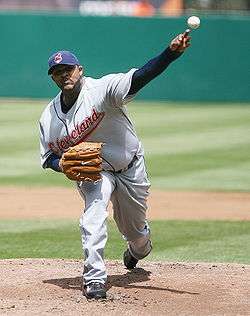
The Indians began their playoff run by defeating the Yankees in the ALDS three games to one. This series will be most remembered for the swarm of bugs that overtook the field in the later innings of Game Two. They also jumped out to a three-games-to-one lead over the Red Sox in the ALCS. The season ended in disappointment when Boston swept the final three games to advance to the 2007 World Series.[87]
Despite the loss, Cleveland players took home a number of awards. Grady Sizemore, who had a .995 fielding percentage and only two errors in 405 chances, won the Gold Glove award, Cleveland's first since 2001.[88] Indians Pitcher CC Sabathia won the second Cy Young Award in team history with a 19–7 record, a 3.21 ERA and an MLB-leading 241 innings pitched.[89] Eric Wedge was awarded the first Manager of the Year Award in team history.[90] Shapiro was named to his second Executive of the Year in 2007.[82]
Second "rebuilding of the team"
The Indians struggled during the 2008 season. Injuries to sluggers Travis Hafner and Victor Martinez, as well as starting pitchers Jake Westbrook and Fausto Carmona led to a poor start.[91] The Indians, falling to last place for a short time in June and July, traded CC Sabathia to the Milwaukee Brewers for prospects Matt LaPorta, Rob Bryson, and Michael Brantley.[92] and traded starting third baseman Casey Blake for catching prospect Carlos Santana.[93] Pitcher Cliff Lee went 22–3 with an ERA of 2.54 and earned the AL Cy Young Award.[94] Grady Sizemore had a career year, winning a Gold Glove Award and a Silver Slugger Award,[95] and the Indians finished with a record of 81–81.
Prospects for the season dimmed early when the Indians ended May with a record of 22–30. Shapiro made multiple trades: Cliff Lee and Ben Francisco to the Philadelphia Phillies for prospects Jason Knapp, Carlos Carrasco, Jason Donald and Lou Marson; Victor Martinez to the Boston Red Sox for prospects Bryan Price, Nick Hagadone and Justin Masterson; Ryan Garko to the Texas Rangers for Scott Barnes; and Kelly Shoppach to the Tampa Bay Rays for Mitch Talbot. The Indians finished the season tied for fourth in their division, with a record of 65–97. The team announced on September 30, 2009, that Eric Wedge and all of the team's coaching staff would be released at the end of the 2009 season.[96] Manny Acta was hired as the team's 40th manager on October 25, 2009.[97]
On February 18, 2010, it was announced that Shapiro (following the end of the 2010 season) would be promoted to team President, with current President Paul Dolan becoming the new Chairman/CEO, and longtime Shapiro assistant Chris Antonetti filling the GM role.[98]
2011–present: Antonetti/Francona era

In his tenure with the Tribe, he is a two-time AL Manager of the Year (2013, 2016) and led the team to the 2016 AL Championship.
On January 18, 2011, longtime popular former first baseman and manager Mike Hargrove was brought in as a special adviser. The Indians started the 2011 season strong – going 30–15 in their first 45 games and seven games ahead of the Detroit Tigers for first place. Injuries led to a slump where the Indians fell out of first place. Many minor leaguers such as Jason Kipnis and Lonnie Chisenhall got opportunities to fill in for the injuries.[99] The biggest news of the season came on July 30 when the Indians traded four prospects for Colorado Rockies star pitcher, Ubaldo Jiménez. The Indians sent their top two pitchers in the minors, Alex White and Drew Pomeranz along with Joe Gardner and Matt McBride.[100] On August 25, the Indians signed the team leader in home runs, Jim Thome off of waivers.[101] He made his first appearance in an Indians uniform since he left Cleveland after the 2002 season. To honor Thome, the Indians placed him at his original position, third base, for one pitch against the Minnesota Twins on September 25. It was his first time playing third base since 1996.[102] This would also be his last appearance as an Indian. The Indians finished the season in 2nd place, 15 games behind the division champion Tigers.[103]

The Indians broke the Opening Day attendance record for Progressive Field with 43,190 against the Toronto Blue Jays on April 5, 2012. The game went on to be the longest opening day game by innings in MLB history. The game was 16 innings and lasted 5 hours and 14 minutes.[104]
On September 27, 2012, with six games left in the Indians' 2012 season, Manny Acta was fired; Sandy Alomar, Jr. was named interim manager for the remainder of the season.[105] On October 6, the Indians announced that Terry Francona, who managed the Boston Red Sox between 2004 and 2011, winning two World Series and leading the team to numerous playoff appearances, would take over as manager of the Indians starting with the 2013 season.[106]
The Indians entered the 2013 season following an active offseason that resulted in a dramatic roster turnover. Key acquisitions included free agent 1B/OF Nick Swisher and CF Michael Bourn.[107] The Indians also added prized right handed pitching prospect Trevor Bauer, OF Drew Stubbs, and relief pitchers Bryan Shaw & Matt Albers in a three-way trade with the Arizona Diamondbacks and Cincinnati Reds that sent RF Shin-Soo Choo to the Reds, and Tony Sipp to the Arizona Diamondbacks[108] Other notable additions included utility man Mike Aviles, catcher Yan Gomes, designated hitter Jason Giambi, and starting pitcher Scott Kazmir.[107][109] The 2013 Indians were able to increase their win total by 24 over 2012 (from 68 to 92), finishing in second place behind Detroit by one game in the Central Division, and securing the number one seed in the American League Wild Card standings. This marked the Indians' first time in postseason play since 2007. The 2013 season ended for the Indians on October 2, losing 4–0 to the Tampa Bay Rays in the 2013 AL Wild Card Game. The turnaround from 2012 also led to Francona winning the 2013 American League Manager of the Year Award.
The Indians had their second consecutive winning season (not done since 2000–2001) in 2014 finishing 85–77. However, they finished third in the AL Central and missed the playoffs, having been eliminated from the AL Wild Card race during the last weekend of the season.
In 2015, after struggling through the first half of the season, the Indians finished 81-80 for their third consecutive winning season, which the team had not done since 1999–2001. The Tribe finished third in the Central for the second straight year, and was eliminated from the Wild Card race during the last week of the season. Following the departure of longtime team executive Mark Shapiro on October 6, the Indians promoted GM Chris Antonetti to President of Baseball Operations, assistant general manager Mike Chernoff to GM, and named Derek Falvey as assistant GM.[110] Falvey was later hired by the Minnesota Twins in 2016, becoming their President of Baseball Operations.
2016: Return to the World Series
The Indians set a franchise record for longest winning streak when they won their 14th consecutive game, a 2–1 win over the Toronto Blue Jays in 19 innings on July 1, 2016 at Rogers Centre.[111] The team clinched the Central Division pennant on September 26, their eighth division title overall and first since 2007, as well as returning to the playoffs for the first time since 2013. They finished the regular season at 94–67, marking their fourth straight winning season, a feat not accomplished since the 1990s and early 2000s.
The Indians began the 2016 postseason by sweeping the Boston Red Sox in the best-of-five American League Division Series. They then defeated the Blue Jays in five games in the 2016 American League Championship Series to claim their sixth American League pennant and advance to the World Series against the Chicago Cubs. It marked the first appearance for the Indians in the World Series since 1997 and first for the Cubs since 1945. The Indians took a 3–1 series lead following a victory in Game 4 at Wrigley Field, but the Cubs rallied to take the final three games and won the series 4 games to 3. The Indians' 2016 success led to Francona winning his second AL Manager of the Year Award with the club.
Season-by-season results
Rivalries
Interleague

Since the introduction of interleague play in 1997, the Indians have developed two rivalries with National League (NL) teams, the Cincinnati Reds and Pittsburgh Pirates, both members of the National League Central. Until 2002, the Indians only played teams from the NL Central in interleague play. The format was changed in 2002 to have the divisions rotate. Since 2003, the Indians and Reds are designated rivals, meaning they play every season regardless of what division is scheduled to play the AL Central that year. The Pirates are not designated rivals so games between the two teams are less frequent.
The rivalry with fellow Ohio team the Cincinnati Reds is known as the Battle of Ohio or Buckeye Series and features the Ohio Cup trophy for the winner. Prior to 1997, the winner of the cup was determined by an annual pre-season baseball game, played each year at minor-league Cooper Stadium in the state capital of Columbus, and staged just days before the start of each new Major League Baseball season. A total of eight Ohio Cup games were played, with the Indians winning six of them. It ended with the start of interleague play in 1997. The winner of the game each year was awarded the Ohio Cup in postgame ceremonies. The Ohio Cup was a favorite among baseball fans in Columbus, with attendances regularly topping 15,000.
Since 1997, the two teams have played each other as part of the regular season, with the exception of 2002. The Ohio Cup was reintroduced in 2008 and is presented to the team who wins the most games in the series that season. Initially, the teams only played one three-game series per season, meeting in Cleveland in 1997 and Cincinnati the following year. Since 1999, the teams have played two series per season against each other, one series at each ballpark. A four-game home-and-home format was introduced in 2013 where the teams play a four-game series with two games in each city back-to-back.[112] This format was also used in 2014 and again in 2016, while the 2015 meetings again featured two separate three-game series. Through the 2016 meetings, the Indians lead the series 54–45.[113]
A small rivalry with the Pittsburgh Pirates stems from the close proximity of the two cities, and features some carryover elements from the longstanding rivalry in the National Football League (NFL) between the Cleveland Browns and Pittsburgh Steelers. Because the Indians' designated interleague rival is the Reds and the Pirates' designated rival is the Detroit Tigers, the teams have played periodically, with one three-game series per season from 1997 to 2001, 2003, 2006, 2009 to 2012, and 2015. Since 2012, the Indians and Pirates play one three-game series every three seasons when the AL Central Division plays the NL Central Division as part of the interleague play rotation. Through the 2015 meetings, the Pirates lead the series 19–17.[114]
Divisional
As the Indians play 19 games every year with each of their A.L. Central competitors, several rivalries have developed.
The Indians have a rivalry with the Detroit Tigers due to the fact that the two cities are fairly close to each other, the teams have been battling for the A.L. Central championship in recent years, and has some carryover elements from the Ohio State-Michigan rivalry, as well as the general historic rivalry between Michiganders and Ohioans dating back to the "Toledo War."
The Indians have had an on and off rivalry with the Chicago White Sox since the 1959 season (when the Sox slipped past the Tribe to win the A.L. pennant), and has intensified since both clubs moved to the A.L. Central. Probably the most infamous moment in the White Sox rivalry was in 1994 when the White Sox confiscated Albert Belle's corked bat, and the ensuing attempt by Indians pitcher Jason Grimsley to crawl through the Comiskey Park (now U.S. Cellular Field) clubhouse ceiling to retrieve it. Belle later moved to the White Sox in 1997, making the rivalry even more intense.
The Indians also have a divisional rivalry with the Kansas City Royals, mainly due to numerous bench clearing brawls in the recent past. The rivalry has intensified when Indians closer Chris Perez used WWE star John Cena's signature "You can't see me" hand gesture towards KC outfielder Jarrod Dyson after striking him out in a game on May 28, 2012.[115]
Uniforms
- See also: Major League Baseball#Uniforms (including image of baseball-cap logos of the 30 MLB franchises)
The Indians' home uniform is white with navy piping around each sleeve. Across the front of the jersey in script font is the word "Indians" in red with a navy outline. The jersey has the Chief Wahoo logo on the left sleeve. The home cap is navy blue with a red bill and features the Chief Wahoo logo on the front. Beginning with the 2016 season, the Indians returned to their 1994–2002 practice of wearing red shirts, belts, and socks with their home uniforms, having worn navy with the home uniform from 2003–2015.
The road uniform is gray, with "Cleveland" in navy blue block letters trimmed in red is across the front of the jersey, navy blue piping around the sleeves, and the Chief Wahoo logo located on the left sleeve. The road cap is navy blue with a red block "C" on the front. The Indians wear navy shirts, belts, and socks with their away uniforms.
The alternate home uniform is cream colored with "Indians" across the front in red block lettering with a dark navy blue outline. The Chief Wahoo logo is located on the left sleeve. This jersey is the only Indians jersey to not have the players' names on the back. The alternate home cap is red with a navy blue block "C" on the front. This uniform is worn during weekend and holiday home games with red shirts, belts, and socks. (Note: This uniform will be dropped for the 2017 season.)
The Indians also feature an alternate fourth jersey which is midnight blue with white piping around each sleeve. Script "Indians" is located across the front of the jersey in the same fashion as the home uniform (red lettering with a white outline); the Chief Wahoo logo is on the left sleeve. When the blue jerseys are worn on the road, the team compliments them with an alternate road cap that is also midnight blue with the Chief Wahoo logo on the front. When the blue jerseys are worn at home, the standard home cap is used.[116]
For all games, the team uses a navy blue batting helmet with a red block "C" on the front.[117]
Fan support and traditions
The Drummer

John Adams, known by baseball fans as "The Drummer", has played a bass drum at nearly every home game since 1973. He is the only fan for whom the team has dedicated a bobble head day.[118] Adams originally paid for his tickets (one for himself, and one for his drum), but recently the Indians have paid for his seats in honor of the contributions he has made to the ballpark atmosphere. He has been featured and interviewed on national TV shows and newspaper articles. [119]
Sellout streak
Between June 12, 1995 and April 4, 2001, the Indians sold out 455 consecutive home games, drawing a total of 19,324,248 fans to Jacobs Field. The demand for tickets was so great that all 81 home games were sold out before Opening Day on at least three separate occasions. The sellout streak set a Major League Baseball record; this was broken by the Boston Red Sox on September 8, 2008, though Boston's Fenway Park is considerably smaller than Progressive Field.[120] One night after the streak ended, the Indians honored the fans by retiring the number 455.
Signature songs
The Indians play "Hang On Sloopy" by The McCoys during the middle of the 8th inning, bringing with it the Ohio State Buckeyes' tradition of the fans chanting "O-H-I-O" during the chorus. They also play "Cleveland Rocks" at the end of the game for Indians wins.[121]
Nickname and logo controversy
The club nickname and its cartoon logo have been criticized for perpetuating Native American stereotypes. In 1997 and 1998, protesters were arrested after effigies were burned. Charges were dismissed in the 1997 case, and were not filed in the 1998 case. Protesters arrested in the 1998 incident subsequently fought and lost a lawsuit alleging that their First Amendment rights had been violated.[122][123][124][125]
Bud Selig (then-Commissioner of Baseball) said in 2014 that he had never received a complaint about the logo. He has heard that there are some protesting mascots, but individual teams such as the Indians and Braves should make their own decisions.[126] Native Americans protested Chief Wahoo on Opening Day 2015, as they have for many years, making note that this is the 100th anniversary of the team becoming the Indians. Owner Paul Dolan, while stating he is respectful of critics, says he mainly hears from fans who want to keep Chief Wahoo, and has no plans to change.[127] However, some fans have responded to the controversy by removing Chief Wahoo logos from purchased apparel, an outcome that is being termed "de-chiefing".[128]
Media

The Indians' flagship radio stations are WTAM AM 1100 and WMMS FM 100.7.[129] The broadcast team consists of longtime "Voice of the Tribe" and six-time NSSA Ohio Sportscaster of the Year Tom Hamilton and Jim Rosenhaus.[130]
The television rights are held by the Fox Sports owned SportsTime Ohio (STO), a network launched in 2006 by the Indians, and purchased by Fox in 2012. Matt Underwood and former Indians Gold Glove winning CF Rick Manning form the announcing team,[130] with veteran Cleveland sportscaster Andre Knott as field reporter,[131] and Al Pawlowski and former Indians pitcher Jensen Lewis as pregame/postgame hosts.[132] Select games are shown on free TV, airing on NBC affiliate WKYC channel 3 via simulcast.
Notable former Indians broadcasters include Tom Manning, Jack Graney (the first ex-baseball player to become a play-by-play announcer), Ken Coleman, Joe Castiglione, Van Patrick, Nev Chandler, Bruce Drennan, Jim "Mudcat" Grant, Rocky Colavito, Dan Coughlin, and Jim Donovan.
Previous broadcasters who have had lengthy tenures with the team include Joe Tait (15 seasons between TV and radio), Jack Corrigan (18 seasons on TV), Ford C. Frick Award winner Jimmy Dudley (19 seasons on radio), Mike Hegan (23 seasons between TV and radio), and Herb Score (34 seasons between TV and radio).[133]
Cleveland Indians in popular culture
The Indians over the years have been featured in numerous movies and television shows. Examples include:
- The Kid From Cleveland – a 1949 film featuring then owner Bill Veeck and numerous players from the team (coming off winning the 1948 World Series).
- Major League – a 1989 film centered around a fictionalized version of the team
- Major League II – a 1994 sequel to the original from five years earlier
- In an episode from the 1968 animated series Go Go Gophers titled "The Cleveland Indians", Indian characters Ruffled Feathers and Running Board not only accused the team of not being real Indians and not wearing any feathers, but also called them fakes.[134]
- In the children's book "Danny Dunn, Time Traveler", when they are sitting around with Benjamin Franklin and explaining their presence in 1763, Danny's role model, a professor, is unable to name any Indian tribe as the one they claimed had captured them. The professor named the only Indian "tribe" he could think of: the Cleveland Indians.
Awards and honors
Baseball Hall of Famers
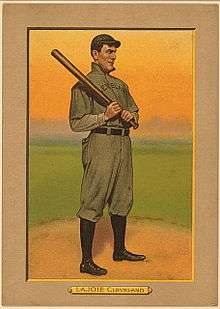
| Cleveland Indians Hall of Famers | |||||||||
|---|---|---|---|---|---|---|---|---|---|
| Affiliation according to the National Baseball Hall of Fame and Museum | |||||||||
|
Ford C. Frick Award recipients
| Cleveland Indians Ford C. Frick Award recipients | |||||||||
|---|---|---|---|---|---|---|---|---|---|
| Affiliation according to the National Baseball Hall of Fame and Museum | |||||||||
|
Retired numbers
|
- Jackie Robinson's number 42 is retired throughout Major League Baseball.
- The number 455 was retired in honor of the Indians fans after the team sold out 455 consecutive games between 1995 and 2001, which was an MLB record until it was surpassed by the Boston Red Sox on September 8, 2008.

Indians Hall of Fame
Statues
Indians players who have had statues made in their honor in front of Progressive Field include:
- Bob Feller (Indians all-time leader in wins and strikeouts by a pitcher) – since 1994
- Jim Thome (Indians all-time leader in home runs and walks by a hitter) – since 2014
- Larry Doby (First black player in the American League and seven-time All-Star) – since 2015
Franchise records
Season records
- Highest batting average: .408, Joe Jackson (1911)
- Most games: 163, Leon Wagner (1964)
- Most runs: 140, Earl Averill (1930)
- Highest slugging %: .714, Albert Belle (1994)
- Most doubles: 64, George Burns (1926)
- Most triples: 26, Joe Jackson (1912)
- Most home runs: 52, Jim Thome (2002)
- Most RBIs: 165, Manny Ramirez (1999)
- Most stolen bases: 75, Kenny Lofton (1996)
- Most wins: 31, Jim Bagby, Sr. (1920)
- Lowest ERA: 1.16, Addie Joss (1908)
- Strikeouts: 348, Bob Feller (1946)
- Complete games: 36, Bob Feller (1946)
- Saves: 46, José Mesa (1995)
Current roster
| Cleveland Indians 2017 spring training roster | |||||||||
|---|---|---|---|---|---|---|---|---|---|
| 40-man roster | Non-roster invitees | Coaches/Other | |||||||
|
Pitchers
|
Catchers
Infielders
Outfielders |
Infielders Outfielders |
Manager Coaches
| ||||||
Minor league affiliations
| Level | Team | League | Location |
|---|---|---|---|
| AAA | Columbus Clippers | International League | Columbus, Ohio |
| AA | Akron RubberDucks | Eastern League | Akron, Ohio |
| Advanced A | Lynchburg Hillcats | Carolina League | Lynchburg, Virginia |
| A | Lake County Captains | Midwest League | Eastlake, Ohio |
| Short Season A | Mahoning Valley Scrappers | New York–Penn League | Niles, Ohio |
| Rookie | AZL Indians | Arizona League | Goodyear, Arizona |
| DSL Indians | Dominican Summer League | Dominican Republic |
References
- ↑ "Indians set to defend AL Central title; New uniforms, ticket strategy usher in 2008 MLB season" (Press release). Cleveland Indians. November 19, 2007. Retrieved October 19, 2016.
- ↑ "Goodyear Ballpark". Cleveland Indians. Retrieved July 10, 2016.
- ↑ "Now that Cubs are champs, Indians have MLB's longest World series drought". Retrieved November 3, 2016.
So, with the Cubs finally on top, the longest championship drought in baseball now belongs to the team they beat - the Indians. Cleveland has not won a World Series since way back in 1948.
- ↑ "The early years–Indians History Overview". Cleveland Indians. Retrieved March 23, 2016.
The Naps lost a then franchise record 102 games in 1914 and attendance sank to disastrous lows as the Lajoie era in Cleveland came to a close. Lajoie's departure, following the 1914 season, prompted a name change for the Cleveland franchise. On January 17, two Cleveland newspapers (The Leader and The Plain Dealer) reported that Indians had been chosen to replace Naps. The Plain Dealer said, "President Somers invited the Cleveland baseball writers to make the selection. The title of Indians was their choice, it having been one of the names applied to the old National League club of Cleveland many years ago." When Chief Sockalexis first arrived, baseball in Cleveland suffered an abrupt downturn in fortune. Now, the Indians would rise to glory with a new owner and star player.
- ↑ Harold 1960: 4
- ↑ "The 1872 Cleveland Forest Citys". retrosheet.org.
- ↑ Schneider, Russell (2001). Cleveland Indians Encyclopedia. Sports Publishing LLC. p. 9. ISBN 1-58261-376-1.
- ↑ "The 1899 Cleveland Spiders". David Fleitz. wcnet.org. Archived from the original on May 1, 2008. Retrieved 2008-07-27.
- ↑ Hittner, Arthur (2003). Honus Wagner: The Life of Baseball's Flying Dutchman. McFarland & Company. ISBN 0-7864-1811-7.
- ↑ "Bob Diskin, Special to ESPN.com, A pitcher worthy of a trophy". Retrieved 14 September 2014.
- ↑ "Project Ballpark". Retrieved 14 September 2014.
- 1 2 3 4 5 Purdy, Dennis (2006). The Team-by-Team Encyclopedia of Major League Baseball. New York City: Workman. ISBN 0-7611-3943-5.
- ↑ Schneider, Russell (2001). Cleveland Indians Encyclopedia. Sports Publishing LLC. p. 11. ISBN 1-58261-376-1.
- ↑ Schneider, Russell (2001). Cleveland Indians Encyclopedia. Sports Publishing LLC. pp. 12–13. ISBN 1-58261-376-1.
- ↑ Seymour, Harold (1960). Baseball. Oxford University Press, US. pp. 214–215. ISBN 0-19-500100-1.
- ↑ "1908 American League Standings". Baseball-Reference.com. Retrieved 2008-06-19.
- ↑ Schneider, Russell (2001). Cleveland Indians Encyclopedia. Sports Publishing LLC. p. 319. ISBN 1-58261-376-1.
- ↑ Schneider, Russell (2001). Cleveland Indians Encyclopedia. Sports Publishing LLC. p. 413. ISBN 1-58261-376-1.
- ↑ "Obituary, Pitcher Joss Dead: Ill Only Few Days" (PDF). New York Times. April 15, 1911. Retrieved 2008-06-20.
- ↑ "1914 American League Standings". Baseball-Reference.com. Retrieved 2008-06-27.
- ↑ "1915 American League Standings". Baseball-Reference.com. Retrieved 2008-06-27.
- ↑ Schneider, Russell (2001). Cleveland Indians Encyclopedia. Sports Publishing LLC. p. 321. ISBN 1-58261-376-1.
- ↑ "Baseball writers select 'Indians' as the best name to apply to the former Naps" The Plain Dealer January 17, 1915: 15
- ↑ "Looking Backwards" The Plain Dealer January 18, 1915: 8
- 1 2 Lewis, Franklin (2006). The Cleveland Indians. Kent State University Press reprint from Putnam. pp. 76–77. ISBN 978-0-87338-885-6.
- ↑ Ratajczak, Kenneth (2008). The Wrong Man Out. AuthorHouse. pp. 76–77. ISBN 1-4343-5678-7.
- ↑ Schneider, Russell (2001). Cleveland Indians Encyclopedia. Sports Publishing LLC. pp. 23–24. ISBN 1-58261-376-1.
- ↑ Ward, Geoffrey C.; Burns, Ken (1996). Baseball: An Illustrated History. Knopf. p. 153. ISBN 0-679-76541-7.
- ↑ "Report of Chapman's Death". New York Times. 1920-08-1. Retrieved 14 September 2014. Check date values in:
|date=(help) - ↑ "Standings – Monday, Aug 16, 1920". Baseball-Reference.com.
- ↑ Berkow, Ira (1989-10-13). "SPORTS OF THE TIMES; When Sewell Replaced Ray Chapman". New York Times. Retrieved 2008-06-27.
- ↑ "CLE 1920 Cleveland Indians Schedule". Baseball Almanac. Retrieved 2009-02-17.
- ↑ "1920 Chicago White Sox Schedule". Baseball Almanac. Retrieved 2009-02-17.
- ↑ Bruce Anderson (March 11, 1985). "When Baseballs Fell from On High, Henry Helf Rose to the Occasion". Sports Illustrated. Archived from the original on November 2, 2012. Retrieved October 20, 2013.
- ↑ C. Phillip Francis. "The Cleveland Crybabies". Chatter from the Dugout. Retrieved 2008-06-27.
- ↑ DeMaio Brewer, Lisa (2000-06-21). "A National Treasure Calls Wilkes "Home"". The Record of Wilkes, N.C. Retrieved 2008-06-27.
- ↑ Housh, Leighton (1965-04-04). "Hal Trosky, Norway, 1965". Des Moines Register. Retrieved 2008-06-27.
- ↑ Schneider, Russell (2001). Cleveland Indians Encyclopedia. Sports Publishing LLC. p. 52. ISBN 1-58261-376-1.
- ↑ Schneider, Russell (2001). Cleveland Indians Encyclopedia. Sports Publishing LLC. pp. 56, 346. ISBN 1-58261-376-1.
- ↑ Boxerman, Burton Alan; Benita W. Boxerman (2003). Ebbets to Veeck to Busch: Eight Owners Who Shaped Baseball. McFarland. p. 128. ISBN 0-7864-1562-2.
- ↑ "Baseball's Clown Prince Dies". CBS News. Retrieved 2008-02-17.
- 1 2 3 4 5 6 Borsvold, David (2003). The Cleveland Indians: Cleveland Press Years, 1920–1982. Arcadia Publishing. pp. 37–38. ISBN 0-7385-2325-9.
- ↑ Lowry, Phillip (2005). Green Cathedrals. New York City: Walker & Company. ISBN 0-8027-1562-1.
- ↑ "League Park may glisten once again". Cleveland Indians.com. Retrieved 2008-06-28.
- ↑ "Satchel Paige 1948 Statistics". Baseball-Reference.com. Retrieved 2008-06-28.
- ↑ "The Kid from Cleveland". IMDB.com. Retrieved 2009-02-17.
- ↑ Ribowsky, Mark (2000). Don't Look Back: Satchel Paige in the Shadows of Baseball. De Capo Press. p. 286. ISBN 0-306-80963-X.
- 1 2 Eisenbath, Mike; Stan Musial (1999). The Cardinals Encyclopedia. Temple University Press. ISBN 1-56639-703-0.
- ↑ Schneider, Russell (2002). Tales from the Tribe Dugout. Sports Publishing LLC. ISBN 1-58261-303-6.
- 1 2 3 Rosenfeld, Harvey (2002). Still a Legend: The Story of Roger Maris. iUniverse. ISBN 0-595-24615-X.
- ↑ Dow, Bill (September 2001). "Former Tiger Norm Cash". Baseball Digest. Retrieved 2006-08-11.
- ↑ Borsvold, David (1960). The Cleveland Indians: Cleveland Press Years, 1920–1982. Arcadia Publishing. p. 81. ISBN 0-7385-2325-9.
- ↑ Gietschier, Steve (1994-09-25). "The Curse of Rocky Colavito: A Loving Look at a Thirty-Year Slump. – book reviews". The Sporting News. Retrieved 2008-06-10.
- 1 2 Grossfeld, Stan (2007-10-12). "Colavito Always Straight Shooter". The Boston Globe. Retrieved 2008-06-29.
- ↑ Riess, Steven (2006). Encyclopedia of Major League Baseball Clubs: Volume 1. Univ of South Carolina Press. p. 1067. ISBN 0-313-32993-1.
- ↑ "The 10-best Yankee Trades of All Time". ESPN.com. 2004-03-01.
- ↑ Murray Chass (1991-07-02). "BASEBALL; Demise and Pall Of the Indians". New York Times. Retrieved 2008-02-17.
- 1 2 Ron Fimrite (1972-05-29). "Circle The Wagons, Indian Uprising!". Sports Illustrated. Archived from the original on August 26, 2012. Retrieved 2008-02-16.
- ↑ Schneider, Russell (2001). Cleveland Indians Encyclopedia. Sports Publishing LLC. p. 352. ISBN 1-58261-376-1.
- ↑ Richard Goldstein (1998-04-28). "Gabe Paul, Ex-Yankee Official, Dies at 88". New York Times. Retrieved 2008-02-16.
- ↑ "The 30 People Who Defined Cleveland 1972-2002: Richard Jacobs".
- ↑ Schneider, Russell (2005). More Tales From the Tribe Dugout. Sports Publishing, LLC. ISBN 1-58261-680-9.
- ↑ Jackson, Paul (2008-06-04). "The night beer and violence bubbled over in Cleveland". Retrieved 2009-02-17.
- 1 2 3 Anthony Castrovince (2006-05-15). "Barker's special night remains vivid". MLB.com. Retrieved 2008-07-01.
- ↑ Stephen Ripley (2007-07-08). "Missing in Action". Winnipeg Sun. Retrieved 2008-07-01.
- ↑ Ron Fimrite (1987-04-06). "Pow! Wow!". Sports Illustrated. Archived from the original on August 26, 2012. Retrieved 2008-02-16.
- ↑ "History Timeline". Cleveland Indians. Retrieved 2016-10-30.
- ↑ Jon Morgan (1995-12-17). "Inside the Browns deal". Baltimore Sun, reprinted by the Chicago Tribune. Retrieved 2008-07-01.
- ↑ "Tax Rise and Domed Stadium Are Voted Down in Cleveland". The New York Times. Associated Press. 05-10-1984. Retrieved 2008-07-01. Check date values in:
|date=(help) - ↑ Jennifer Stoffel (1990-06-13). "New Sports Complex for Cleveland". New York Times. Retrieved 2008-07-01.
- ↑ "The Official Site of The Cleveland Indians: History: Indians History". Major League Baseball, Cleveland Indians. Retrieved 2009-02-17.
- ↑ Jayson Stark (2003-03-21). "Ten years later, the pain is still there". ESPN.com. Retrieved 2008-06-30.
- ↑ "Indians plan to sell additional tickets". The New York Times. Associated Press. March 7, 1996. Retrieved October 19, 2016.
- ↑ "No work Yankees". Sports Illustrated. 1998-10-15. Archived from the original on June 19, 2001. Retrieved 2008-09-08.
- ↑ Newhan, Ros (1998-11-29). "Early Returns Favor Braves". Los Angeles Times. Retrieved 2008-09-08.
- 1 2 Lapointe, Joe (1999-10-10). "1999 PLAYOFFS: DIVISION SERIES; Red Sox Find Answers, Raising More Questions". New York Times. Retrieved 2008-09-08.
- ↑ "Red Sox headed to ALCS after beating Cleveland 12–8". CNNSI.com. 1999-10-12. Archived from the original on July 14, 2007. Retrieved 2008-09-08.
- ↑ John Snyder (2008). Indians Journal. Menasha Ridge Press. ISBN 1-57860-308-0.
- ↑ "Standings on Sunday, July 9, 2000 - Baseball-Reference.com".
- ↑ "Cleveland Indians sold to Dolan". CBS Marketwatch. 1999-11-04. Retrieved 2008-09-08.
- ↑ "Vizquel's six hits tie AL record". ESPN. 2004-08-31. Retrieved 2008-06-08.
- 1 2 "Northeast Ohio". Retrieved 14 September 2014.
- ↑ "BASEBALL; Hafner's 6th Grand Slam Ties Mattingly". New York Times. 2006-08-14. Retrieved 2009-03-20.
- ↑ Ruddick, Chris (2007-03-27). "Cleveland Indians 2007 Preview". News Net 5. Archived from the original on March 24, 2012. Retrieved 2009-03-21.
- ↑ Castrovince, Anthony (2007-03-30). "Indians Opening Day outlook". MLB.com. Retrieved 2009-03-21.
- ↑ Crasnick, Jerry (2007-10-04). "Lofton keeps on ticking, delivers huge performance for Indians". ESPN. Retrieved 2009-03-21.
- 1 2 "Boston Red Sox vs. Cleveland Indians". Washington Post. 2007-10-12. Retrieved 2009-03-21.
- ↑ Castrovince, Anthony (2007-11-06). "Sizemore earns first Gold Glove Award". MLB.com. Retrieved 2009-03-20.
- ↑ "Sabathia only second Indians pitcher to win Cy Young". ESPN. 2007-11-14. Retrieved 2009-03-21.
- ↑ "Wedge, Melvin voted baseball's top managers". CBC Sports. 2007-11-14. Retrieved 2009-03-20.
- ↑ Antonen, Mel (2008-12-25). "Indians have closer in fold, but infield in flux". USA Today. Retrieved 2009-03-21.
- ↑ Curry, Jack (2008-07-08). "Looking to Postseason, Brewers Trade for Sabathia". New York Times. Retrieved 2009-03-21.
- ↑ "Carlos Santana Stats, Highlights, Bio – MiLB.com Stats – The Official Site of Minor League Baseball". MiLB.com. Retrieved 14 September 2014.
- ↑ "Cleveland lefty Cliff Lee wins AL Cy Young Award". International Herald Tribune. 2009-11-13. Retrieved 2009-03-20.
- ↑ Beck, Jason (2008-11-13). "Sizemore adds Silver Slugger to list". MLB.com. Retrieved 2009-03-20.
- ↑ Castrovince, Anthony (2009-09-30). "Indians dismiss Wedge, coaching staff". Cleveland Indians.
- ↑ Castrovince, Anthony (2009-10-25). "Tribe tabs Acta to be new manager". MLB.com. Retrieved 2009-10-25.
- ↑ Hoynes, Paul (2010-02-19). "Cleveland Indians know what future holds, announce plan for changes in front office". The Plain Dealer. Cleveland, Ohio. Retrieved 2010-02-20.
- ↑ "MLB Preview – Toronto Blue Jays at Cleveland Indians – Apr 05, 2012". CBSSports.com. Retrieved 2013-01-23.
- ↑ "Ubaldo Jimenez traded to Indians for four players". USATODAY.COM. Retrieved 14 September 2014.
- ↑ AP File. "Back where he began: Cleveland Indians obtain Jim Thome from Twins for player to be named". cleveland.com. Retrieved 2013-01-23.
- ↑ Northeast Ohio. "Minnesota Twins beat Cleveland Indians, 6–4, in 10 innings; Jim Thome makes appearance at 3B". cleveland.com. Retrieved 2013-01-23.
- ↑ "Most Popular E-mail Newsletter". USA Today. 2012-04-03.
- ↑ "Blue Jays Win Longest Opening Day Game In History | WBAL Home – WBAL Home". Wbaltv.com. 2012-04-06. Retrieved 2013-01-23.
- ↑ "Cleveland Indians fire manager Manny Acta". ESPN. Retrieved 31 March 2013.
- ↑ "Francona Hired as Indians manager". Fox Sports. Retrieved 31 March 2013.
- 1 2 Rosenthal, Ken. "Bourn makes Tribe relevant again". Fox Sports. Retrieved 31 March 2013.
- ↑ Baskin, Andy (5 March 2013). "Getting to know your 2013 Indians: Trevor Bauer". News Net 5. Retrieved 31 March 2013.
- ↑ Hoynes, Paul. "Cleveland Indians 2013: A look back at their significant offseason moves". Cleveland.com. Retrieved 31 March 2013.
- ↑ TEGNA. "Cleveland Indians promote Chris Antonetti to President".
- ↑ "Indians' streak hits 14 after 19-inning win vs. Jays".
- ↑ Schlegel, John (May 23, 2013). "On schedule: New Interleague format brings twists". MLB.com. Major League Baseball. Retrieved May 20, 2016.
- ↑ "Head-to-Head results for Cleveland Indians vs. Cincinnati Reds from 1901 to 2016". Baseball-Reference.com. Sports Reference LLC. 2016. Retrieved May 20, 2016.
- ↑ "Head-to-Head results for Cleveland Indians vs. Pittsburgh Pirates from 1901 to 2016". Baseball-Reference.com. Sports Reference LLC. 2016. Retrieved May 20, 2016.
- ↑ "Jarrod Dyson not pleased with Chris Perez's gesture after strikeout".
- ↑ Indians new uniforms Cleveland.com
- ↑ "Indians To Go With Just Block "C" On Batting Helmets For 2013 Season".
- ↑ Bare, Andrew (2006-07-19). "No new-school drummer boy". MLB.com. Retrieved 2009-06-08.
- ↑ Crump, Sarah (2009-06-06). "Pound for pound, there's no greater Tribe fan around: Sarah Crump's My Cleveland". The Plain Dealer. Retrieved 2009-06-08.
- ↑ "Red Sox fans break MLB record for most consecutive sellouts". MLB Advanced Media, L.P. September 8, 2008. Retrieved February 9, 2009.
- ↑ "Stadium Songs: Cleveland Indians".
- ↑ "court TV becomes truTV". Web.archive.org. 2012-12-07. Archived from the original on 2007-10-12. Retrieved 2013-01-23.
- ↑ "Workers World Nov. 6, 1997: Native leaders arrested during World Series". Workers.org. 1997-11-06. Retrieved 2013-01-23.
- ↑ Bellecourt v. Cleveland, 104 Ohio St, 3d. 439 (Ohio State Supreme Court 2004).
- ↑ "Supreme Court of Ohio Case Summaries". Supremecourt.ohio.gov. Retrieved 2013-01-23.
- ↑ Erik Brady (July 15, 2014). "Selig claims he's received no complaints over Cleveland Indians' logo". USA Today.
- ↑ Tom Beres (April 9, 2015). "Wahoo Protesters: A century of 'Indians' is enough". WKYC-TV.
- ↑ Paul Lukas (April 2, 2014). "Hail To De-Chiefing". ESPN.com.
- ↑ "Radio Affiliates". Clevelandindians.com. Retrieved 2008-02-16.
- 1 2 "Broadcaster". Clevelandindians.com. Retrieved 2008-02-16.
- ↑ Sports Media notes Lake County News Herald
- ↑ Storm, Stephanie. "Former pitcher Jensen Lewis finds second dream job as part of Indians' television team".
- ↑ Dolgan, Bob (November 11, 2008). "Former Indians broadcaster Herb Score dies at age 75". Cleveland Plain Dealer. Retrieved February 16, 2008.
- ↑ "Go Go Gophers – The Cleveland Indians". YouTube. Retrieved July 19, 2014.
External links
| Wikimedia Commons has media related to Cleveland Indians. |
- Official website
- Cleveland Indians 1998 Annual Report, the last filed with the SEC
- Sports E-Cyclopedia

